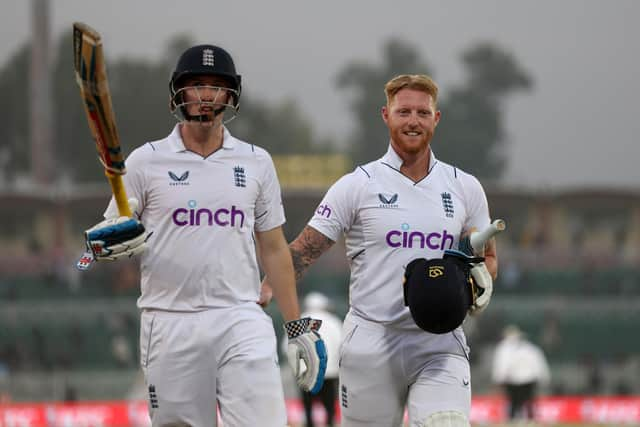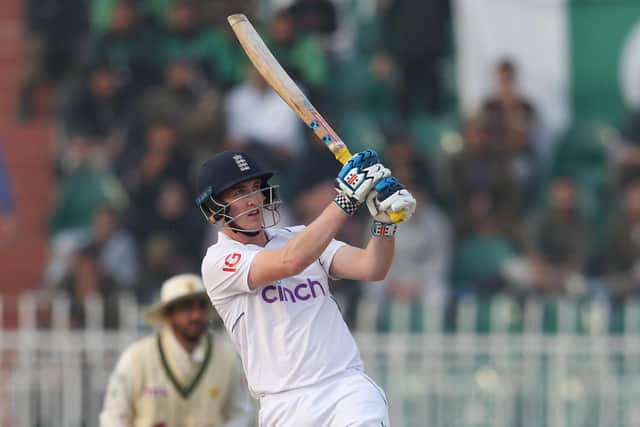Harry Brook-inspired England almost beat Gillette Cup record total at same stage of Test match
It seemed like a good time to check the highest score ever made in the Gillette Cup, the first top-level one-day competition played in England over 60 overs-a-side for all but one year of its duration between 1963 and 1980.
Incredibly, England’s score at the same stage was just one shy of that figure - Hampshire’s 371-4 from 60 overs against Glamorgan at Southampton in 1975, itself way ahead of the second-highest score (Somerset’s 330-4 against Glamorgan from 60 overs at Cardiff in 1978).
Advertisement
Hide AdAdvertisement
Hide AdOf all the statistics on a remarkable first day, which England closed on 506-4 from 75 overs before the light closed in, few evidenced more clearly how the game is changing and how England are changing it under captain Ben Stokes and head coach Brendon McCullum.


Forget “Bazball”, this was “Bonkersball”, a rate of scoring so absurd that Andy Zaltzman, the Test Match Special statistician, could have been forgiven for heading for the nearest darkened room while his predecessor, Bill Frindall, turned in his grave.
As Fred would have said through plumes of pipe smoke: “I don’t know what’s going off out there.”
Nor do we, Fred. Nor do we.
For after Zak Crawley, Ben Duckett, Ollie Pope and Yorkshire’s very own Harry Brook had scored hundreds, Brook’s his first at Test level on only his second appearance, one had to keep reminding oneself that this was, indeed, day one of a Test match, day one of a series, when once a score of 206-4 from 75 overs, say, exactly 300 runs fewer than England managed, would have been perfectly normal.


Advertisement
Hide AdAdvertisement
Hide AdThe comparisons with white-ball cricket came thick and fast.
After 20 overs, England’s score was 141-0; after 50 overs, it was 305-3 - respectable run-rates in the Vitality Blast and One-Day Cup, let alone in the longest and most challenging format of the game.
Where to begin?
It must be with Brook.
His was the fastest and perhaps best innings of the day, the 23-year-old reaching three figures from just 80 balls with 14 fours and two sixes, one pulled sweetly off Haris Rauf, his team-mate at Headingley last season.
At one point, Brook hit Saud Shakeel, a left-arm spinner and one of four Test debutants in the Pakistan team along with Rauf, for six fours in one over, becoming the eighth man to achieve that feat in Tests.
Advertisement
Hide AdAdvertisement
Hide AdPerhaps most impressively, on reaching his century with a classical cover-drive that was symptomatic of the stylish rather than swashbuckling way that England played, Brook did not run yelping down the pitch in self-absorbed style but quietly removed his helmet, broke out into a wide smile and calmly reciprocated the mid-pitch hug of a captain who clearly likes the cut of his cricketing jib.
The detail is unlikely to detain him but had Brook reached three-figures just five balls earlier, as seemed likely at one stage, he would have beaten Gilbert Jessop’s record for the fastest Test hundred for England, made against Australia at The Oval in 1902. “Gilbert who?” one could almost hear the Brook-meister saying to assembled media.
Jonny Bairstow, missing this series through injury, almost beat “The Croucher” himself last summer with a 77-ball hundred against New Zealand at Trent Bridge. No matter. Brook will have another chance - as will hopefully Bairstow.
It was almost a footnote that Crawley’s 86-ball hundred was the fastest by an England opener in Tests, and Duckett’s 105-ball effort the third-fastest.
Advertisement
Hide AdAdvertisement
Hide AdOn his first Test appearance for over six years, it was a fine comeback by Duckett, the openers leading England to 174-0 at lunch. Yum-yum.
Pope breasted three figures from 90 balls and played brilliantly, while Stokes thumped 34 from 15 at the end, ensuring that England became the first to score 500 on the first day of a Test.
It was crazy baby, the cricketing equivalent of watching Hendrix at Woodstock in 1969 under the influence of psychedelic mushrooms.
What must the old-timers make of it all?
Going back to the Gillette Cup, then the best that a one-day fan could get, it is striking to observe that there were only 16 team totals of 300 or more in its 18 seasons, one of the most famous being Yorkshire's 317-4 in the 1965 final.
Advertisement
Hide AdAdvertisement
Hide AdThat was the match in which Geoffrey Boycott scored a magnificent 146, displaying a different side to a game famously built on a rock-solid technique in the first-class arena.
The sport has changed utterly since then, although the challenge for the “Bazball” generation is the same - to achieve consistency and longevity.
Brook, in particular, looks primed to do that, while Pope gets better and better, ensuring that there is no longer such pressure on Joe Root, who could almost – but not quite – laugh off a low score on a flat pitch.